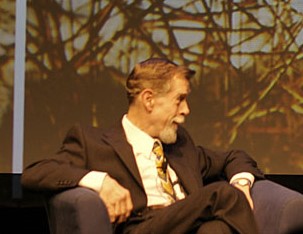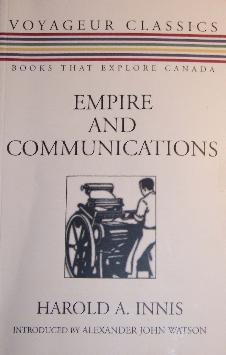Related Research Articles

Herbert Marshall McLuhan was a Canadian philosopher whose work is among the cornerstones of the study of media theory. He studied at the University of Manitoba and the University of Cambridge. He began his teaching career as a professor of English at several universities in the United States and Canada before moving to the University of Toronto in 1946, where he remained for the rest of his life. He is known as the "father of media studies".

Media studies is a discipline and field of study that deals with the content, history, and effects of various media; in particular, the mass media. Media Studies may draw on traditions from both the social sciences and the humanities, but mostly from its core disciplines of mass communication, communication, communication sciences, and communication studies.

Harold Adams Innis was a Canadian professor of political economy at the University of Toronto and the author of seminal works on media, communication theory, and Canadian economic history. He helped develop the staples thesis, which holds that Canada's culture, political history, and economy have been decisively influenced by the exploitation and export of a series of "staples" such as fur, fish, lumber, wheat, mined metals, and coal. The staple thesis dominated economic history in Canada from the 1930s to 1960s, and continues to be a fundamental part of the Canadian political economic tradition.
Media ecology theory is the study of media, technology, and communication and how they affect human environments. The theoretical concepts were proposed by Marshall McLuhan in 1964, while the term media ecology was first formally introduced by Neil Postman in 1968.

Eric Marshall McLuhan was a communications theorist, son of Marshall McLuhan.

Understanding Media: The Extensions of Man is a 1964 book by Marshall McLuhan, in which the author proposes that the media, not the content that they carry, should be the focus of study. He suggests that the medium affects the society in which it plays a role mainly by the characteristics of the medium rather than the content. The book is considered a pioneering study in media theory.

Derrick de Kerckhove is the author of The Skin of Culture and Connected Intelligence and Professor in the Department of French at the University of Toronto, in Toronto, Ontario, Canada. He was the Director of the McLuhan Program in Culture and Technology from 1983 until 2008.

A sensorium (/sɛnˈsɔːrɪəm/) is the apparatus of an organism's perception considered as a whole, the "seat of sensation" where it experiences, perceives and interprets the environments within which it lives. The term originally entered English from the Late Latin in the mid-17th century, from the stem sens- ("sense"). In earlier use it referred, in a broader sense, to the brain as the mind's organ. In medical, psychological, and physiological discourse it has come to refer to the total character of the unique and changing sensory environments perceived by individuals. These include the sensation, perception, and interpretation of information about the world around us by using faculties of the mind such as senses, phenomenal and psychological perception, cognition, and intelligence.
Robert K. Logan, originally trained as a physicist, is a media ecologist.

"The medium is the message" is a phrase coined by the Canadian communication theorist Marshall McLuhan and the name of the first chapter in his Understanding Media: The Extensions of Man, published in 1964. McLuhan proposes that a communication medium itself, not the messages it carries, should be the primary focus of study. He showed that artifacts such as media affect any society by their characteristics, or content.

Empire and Communications is a book published in 1950 by University of Toronto professor Harold Innis. It is based on six lectures Innis delivered at Oxford University in 1948. The series, known as the Beit Lectures, was dedicated to exploring British imperial history. Innis, however, decided to undertake a sweeping historical survey of how communications media influence the rise and fall of empires. He traced the effects of media such as stone, clay, papyrus, parchment and paper from ancient to modern times.
Medium theory is a mode of analysis that examines the ways in which particular communication media and modalities impact the specific content (messages) they are meant to convey. It Medium theory refers to a set of approaches that can be used to convey the difference in meanings of messages depending on the channel through which they are transmitted. Medium theorists argue that media are not simply channels for transmitting information between environments, but are themselves distinct social-psychological settings or environments that encourage certain types of interaction and discourage others.

Monopolies of knowledge arise when the ruling class maintains political power through control of key communications technologies. The Canadian economic historian Harold Innis developed the concept of monopolies of knowledge in his later writings on communications theories.

Marshall McLuhan's tetrad of media effects uses a tetrad - a four-part construct - to examine the effects on society of any technology/medium by dividing its effects into four categories and displaying them simultaneously. The tetrad first appeared in print in articles by McLuhan in the journals Technology and Culture (1975) and et cetera (1977). It first appeared in book form in his posthumously-published works Laws of Media (1988) and The Global Village (1989).
The McLuhan Program in Culture and Technology started in 1963 as the Centre for Culture and Technology, initially a card pinned to the door of Marshall McLuhan's office in the English department at the University of Toronto. In 1965, McLuhan draft Constitution for the center read: "The Centre is established to advance the understanding of the origins and effects of technology" to "investigation into the psychic and social consequences of technologies."
The alphabet effect is a group of hypotheses in communication theory arguing that phonetic writing, and alphabetic scripts in particular, have served to promote and encourage the cognitive skills of abstraction, analysis, coding, decoding, and classification. Promoters of these hypotheses are associated with the Toronto School of Communication, such as Marshall McLuhan, Harold Innis, Walter Ong, Vilém Flusser and more recently Robert K. Logan; the term "alphabet effect" comes from Logan's 1986 work.
Communication Aesthetics is a theory devised by Mario Costa and Fred Forest at Mercato San Severino in Italy in 1983. It is a theory of aesthetics calling for artistic practice engaging with and working through the developments, evolutions and paradigms of late twentieth century communications technologies. Observing the emerging supremacy of networks over subjects, it called for an artistic approach that was both adapted to, and invested in this changing techno-social arena.
This is a bibliography of Marshall McLuhan's works.
Harold Adams Innis was a professor of political economy at the University of Toronto and the author of seminal works on Canadian economic history and on media and communication theory. He helped develop the staples thesis, which holds that Canada's culture, political history and economy have been decisively influenced by the exploitation and export of a series of staples such as fur, fish, wood, wheat, mined metals and fossil fuels. Innis's communications writings explore the role of media in shaping the culture and development of civilizations. He argued, for example, that a balance between oral and written forms of communication contributed to the flourishing of Greek civilization in the 5th century BC. But he warned that Western civilization is now imperiled by powerful, advertising-driven media obsessed by "present-mindedness" and the "continuous, systematic, ruthless destruction of elements of permanence essential to cultural activity."
In the social sciences, materiality is the notion that the physical properties of a cultural artifact have consequences for how the object is used. Some scholars expand this definition to encompass a broader range of actions, such as the process of making art, and the power of organizations and institutions to orient activity around themselves. The concept of materiality is used across many disciplines within the social sciences to focus attention on the impact of material or physical factors. Scholars working in science and technology studies, anthropology, organization studies, or communication studies may incorporate materiality as a dimension of their investigations. Central figures in the social scientific study of materiality are Harold Innis and Marshall McLuhan.
References
- 1 2 Derrick de Kerckhove, "McLuhan and the Toronto School of Communication”, Canadian Journal of Communication (1989): 73
- ↑ "History and Mandate". The McLuhan Program in Culture and Technology. Archived from the original on 21 September 2003. Retrieved 15 November 2008.
- ↑ Logan, Robert K. (1986). The Alphabet Effect . New York: William Morrow and Company. p. 22. ISBN 978-0-312-00993-9.
- ↑ Olson, David R. (1994). The World on Paper: The Conceptual and Cognitive Implications of Writing and Reading. Cambridge: Cambridge University Press. p. 15. ISBN 978-0-521-57558-4.
- ↑ Murray, Oswyn. "The Word is Mightier than the Pen". The Times Literary Supplement . 4 (498): 655.
- ↑ Carey, (McLuhan Pro and Con), p. 271.
- ↑ "ARCHIVED - Introduction - Old Messengers, New Media: The Legacy of Innis and McLuhan - Library and Archives Canada".
- ↑ See Blondheim and Watson, The Toronto School of Communication Theory: Interpretations, Extensions, Applications; de Kerckhove, "McLuhan and the Toronto School of Communication"
- ↑ Watson, John Alexander. (2006) Marginal Man: The Dark Vision of Harold Innis. Toronto: University of Toronto Press, p.224.
- ↑ Innis, Harold. (2007) Empire and Communications. Toronto: Dundurn Press, p.23. ISBN 978-1-55002-662-7. This is the fourth and latest edition of Innis's book. The original edition of 1950 published by Oxford University Press was reissued in 1972 by University of Toronto Press, edited by Mary Quayle Innis with an introduction by Marshall McLuhan. An illustrated third edition was published by Press Porcepic in 1986.
- 1 2 Innis (Empire), p.26.
- ↑ Innis (Empire), p.27.
- ↑ See, for example, Innis's discussion of the priestly monopoly over writing that undermined the Egyptian empire. Innis (Empire) pp.44-45.
- ↑ Innis, Harold. (1951) The Bias of Communication. Toronto: University of Toronto Press, pp.3-4.
- ↑ Innis, (Bias) p.4.
- ↑ Heyer, p.43.
- ↑ Gutenberg Galaxy 1962, p. 41.
- ↑ Understanding Media, p. 8.
